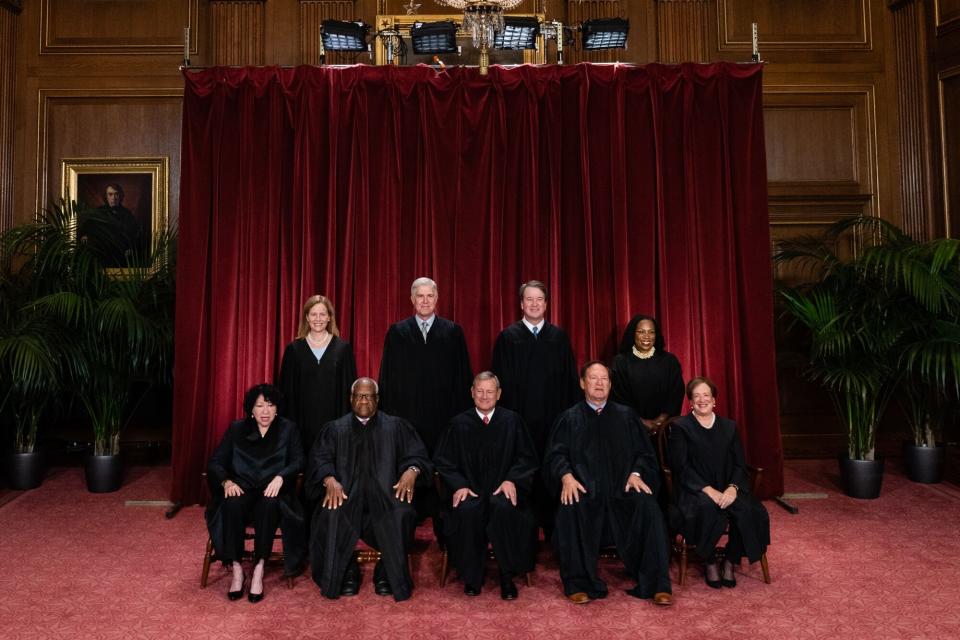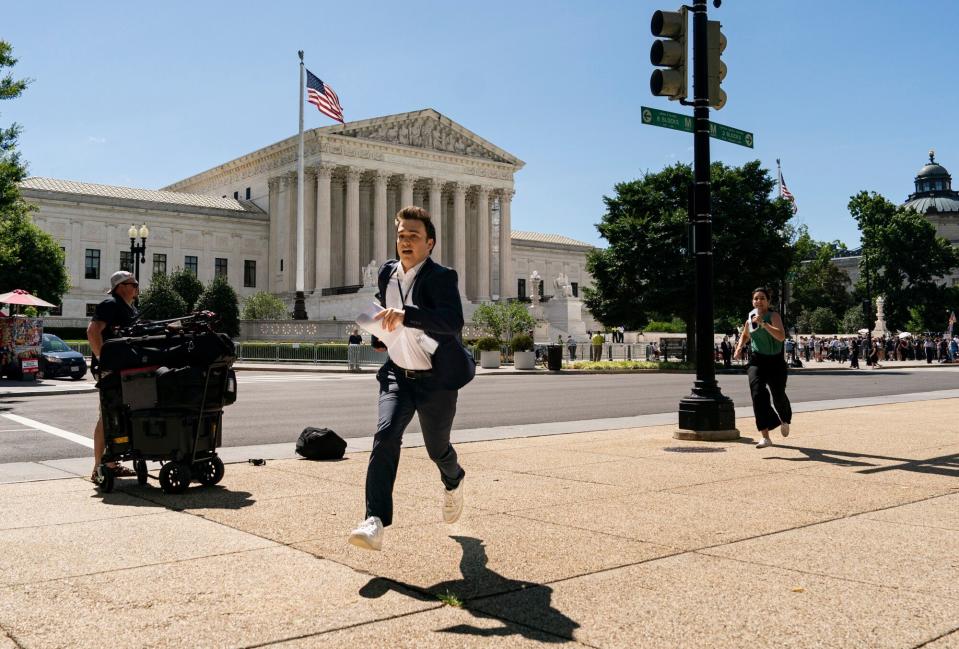Supreme Court’s Winners This Term: Trump, Wall Street and Conservatives
(Bloomberg) -- The conservative revolution at the US Supreme Court gained steam with another transformational term, as the Republican-appointed supermajority slashed the power of regulators, lifted legal clouds from Donald Trump’s presidential bid and laid groundwork for future blockbusters.
Most Read from Bloomberg
Biden Struggles to Contain Mounting Pressure to Drop Out of Race
China Can End Russia’s War in Ukraine With One Phone Call, Finland Says
In a polarizing session that was low on numbers but high on impact, the court’s conservative wing used its muscle to both push through long-sought legal priorities and resolve novel issues in a way that buoyed Trump and his fellow Republicans.
And even where they rejected conservative-backed arguments – as they did in cases over abortion and taxes – the justices often did so on narrow grounds that left avenues for future legal showdowns.
“This has been a wonderful term,” said Carrie Severino, president of the JCN, which has helped push for more conservative judges on the bench. The court “made some incredibly important decisions that will help preserve our constitutional separation of powers and balance of power.”
The court capped its term by giving Trump partial immunity from criminal charges over his efforts to overturn his 2020 election loss. The decision means Trump won’t face trial before his Nov. 5 presidential election rematch with Joe Biden.
That ruling came days after big-government foes and business groups claimed a long-sought prize: The court overturned the 1984 Chevron v. Natural Resources Defense Council decision, which had given agencies broad latitude to define the reach of their authority by interpreting ambiguous statutes.
It was the third straight term to finish with watershed rulings, including overturning precedents. In the two previous terms, the court eliminated constitutional abortion protections, declared a right to carry handguns, expanded religious freedoms and outlawed race-conscious college admissions.
Liberal Fears
The latest session left the court’s outnumbered liberals to dissent in increasingly dire terms. On the last opinion day alone, Justice Ketanji Brown Jackson said the court’s regulatory decisions could “devastate the functioning of the federal government,” while Justice Sonia Sotomayor said the Trump immunity ruling left her “with fear for our democracy.”
The court’s six-justice conservative majority includes three appointed by Trump – Neil Gorsuch, Brett Kavanaugh and Amy Coney Barrett – along with veterans John Roberts and Clarence Thomas and Samuel Alito.
That group formed the majority in 6-3 cases 11 times, according to Empirical Scotus, a website that tracks the court’s work. The court issued only 59 rulings, well below its modern average, according to its website.
The 6-3 rulings include three major regulatory decisions. The court said that people or companies sued for damages by the Securities and Exchange Commission have a right to a jury trial in federal court, letting them bypass the agency’s in-house judges.
And the court amplified the Chevron decision with a last-day ruling giving some opponents more time to sue over years-old regulations.
That ruling was “the cherry on top of the sundae,” said John Malcolm, vice president of the Institute for Constitutional Government at the conservative Heritage Foundation. “It’s now going to give all sorts of people whose livelihoods are dramatically affected by regulations an opportunity to have their day in court.”
All three decisions are likely to reverberate across the federal government, affecting a plethora of other agencies.
In another decision, this time with Barrett joining the liberals in dissent, the court blocked the Biden administration from imposing stringent new emissions requirements on power plants and pipelines in parts of the country.
“The court is on a mission here,” said Sam Sankar, senior vice president of programs at Earthjustice. “It’s just a full-on assault against the power of the federal government to regulate in the public interest.”
Trump Wins
Trump may have been the term’s biggest winner. The court ruled unanimously he can appear on presidential ballots, even though a Colorado court found that he was an insurrectionist who incited the Jan. 6 Capitol riot.
Trump also could benefit from a 6-3 ruling that limited the Justice Department’s use in Jan. 6 prosecutions of a 2002 law that makes it a crime to obstruct an official proceeding. Trump is expected to invoke the ruling to try to pare back his federal election-interference prosecution.
All that was a lead-up to the immunity ruling, the first time the court has ever said that former presidents are shielded from prosecution for some things they do in office.
“The court showed its colors — formally granting Donald Trump an expansive immunity after effectively giving him pre-election immunity by dragging out his case,” said Leah Litman, a professor of constitutional law at the University of Michigan.
Conservatives were also victorious in decisions that backed the power of cities to ban homeless people from sleeping outside in public places, made it harder to challenge voting maps as racial gerrymanders, and struck down a federal ban on rapid-fire devices known as bump stocks.
Conservative losses often came with consolation prizes. When the court upheld a 2017 tax on US-owned businesses’ foreign profits, the majority made clear it wasn’t also approving Democratic proposals for a wealth tax — an issue that lurked in the background. Four justices indicated they would strike down a wealth tax.
And when the court twice declined to put new restrictions on abortion, it didn’t conclusively resolve the core issues in either case. The court said anti-abortion doctors and groups lacked legal standing to seek restrictions on the abortion pill mifepristone, but left open the possibility that other opponents could sue.
Similarly, a decision letting abortions take place in medical emergencies in Idaho was only a stopgap that didn’t resolve whether a federal hospital law protects patients in states with near-total bans on the procedure.
“Today’s decision is not a victory for pregnant patients in Idaho. It is delay,” Jackson wrote in the case. The decision came with an usual twist when Bloomberg obtained an advance copy after the court inadvertently posted the decision briefly online a day early.
A setback for gun rights was similarly narrow as the court upheld a federal ban on firearms possession by people under domestic violence orders. The 8-1 ruling, which said governments have long disarmed dangerous people, stopped short of approving other federal restrictions, including a prohibition that applies to convicted felons.
Liberals won a rare victory when the court cleared the Biden administration to communicate freely with social media companies. The ruling rejected a conservative-backed lawsuit alleging the government had bullied platforms into taking down posts about the pandemic and the 2020 election.
And the Biden administration secured a decision upholding the Consumer Financial Protection Bureau’s funding system. But even that came with the twist of the ruling being written by the arch-conservative Thomas, who said the funding mechanism had historical roots.
“I was disappointed to see the result,” said Malcolm of the Heritage Foundation. “But I can’t say in my own mind that I think it’s dead wrong.”
--With assistance from Jennifer A. Dlouhy.
Most Read from Bloomberg Businessweek
China’s Investment Bankers Join the Communist Party as Morale (and Paychecks) Shrink
Dragons and Sex Are Now a $610 Million Business Sweeping Publishing
The Fried Chicken Sandwich Wars Are More Cutthroat Than Ever Before
For Tesla, a Smaller Drop in Sales Is Something to Celebrate
©2024 Bloomberg L.P.

 Yahoo Finance
Yahoo Finance 



